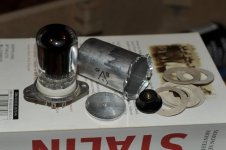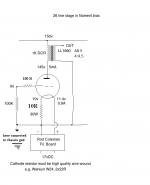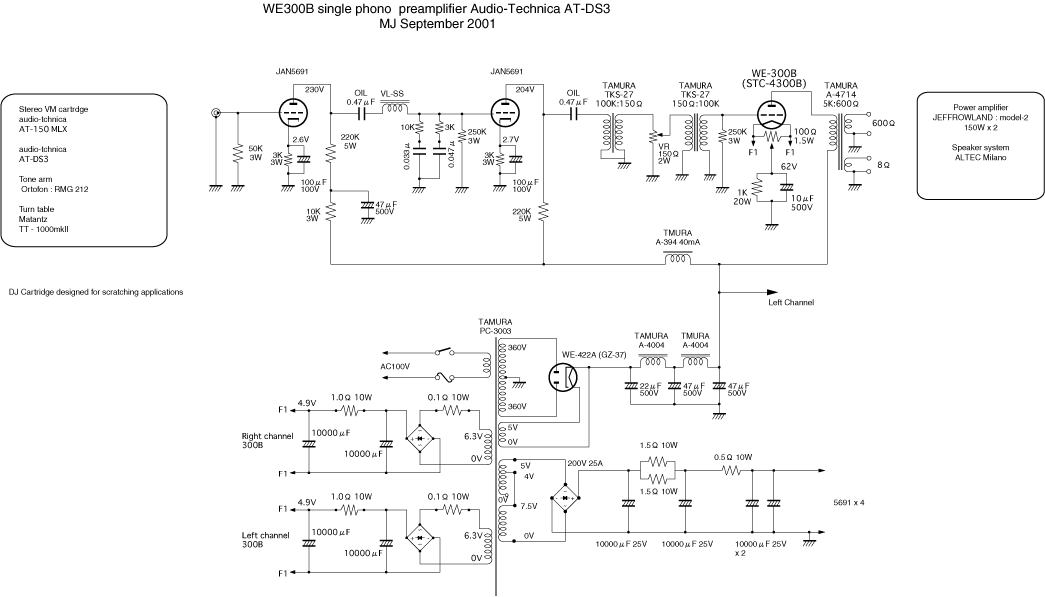Dang, did I start all this?
464 pages... wow... better get some booz and pizza
I'm going to rebuild my system, including the 26 in a preamp role somehow, as I tore everything down over a decade ago. I'm looking forward to reading your experiences here in this topic. Awesome to know this little tube has not been forgotten.
BTW: I plan to make a new gallery of all the 26s I have and post some curves with my new eTracer on my revamped (but not yet complete) site at VT52.com. (yes, shameless plug).
Cheers guys!
464 pages... wow... better get some booz and pizza
I'm going to rebuild my system, including the 26 in a preamp role somehow, as I tore everything down over a decade ago. I'm looking forward to reading your experiences here in this topic. Awesome to know this little tube has not been forgotten.
BTW: I plan to make a new gallery of all the 26s I have and post some curves with my new eTracer on my revamped (but not yet complete) site at VT52.com. (yes, shameless plug).
Cheers guys!
Last edited:
Hello Jim,
your site VT52 was a revelation to me !
You made me discover wonders, like 26 and AZ1 mesh and old european direct heated tubes. Here was too a great sharing with all the contributors, thank's for all.
I built my 26 five or six years ago, modifying it according the infos here. My recipe is very simple, biasing the tube with a 9V battery (like Coolzero), AZ1 mesh, RC coupled. I will finally decide to use a tango trans NP126 at the output, mainly for control the phase at the output).
The association with a SE 300B (Reichert base with separate PS for input & 300B) is great ! I do not get enough...
Thanks again Mister Jim ;-)
B r u n o
your site VT52 was a revelation to me !
You made me discover wonders, like 26 and AZ1 mesh and old european direct heated tubes. Here was too a great sharing with all the contributors, thank's for all.
I built my 26 five or six years ago, modifying it according the infos here. My recipe is very simple, biasing the tube with a 9V battery (like Coolzero), AZ1 mesh, RC coupled. I will finally decide to use a tango trans NP126 at the output, mainly for control the phase at the output).
The association with a SE 300B (Reichert base with separate PS for input & 300B) is great ! I do not get enough...
Thanks again Mister Jim ;-)
B r u n o
Glad you enjoyed the site!!!!
How do you like the Tango? They always seems like unobtainium to me. I was lucky to have several good winders here in NL like Tribute and AE, to make amorphous magic. I want to use a line-out for my new 26 build, most likely LL2763 to get 2:1 or very maybe 4:1. I've mainly done RC or LC, but not much experience with step-downs; always seemed such a waste to have a low-mu dht and then destroy all it's gain with a step-down. But 2:1 might be a good compromise, as my cables are short.
But, wow. Tubes these days are insanely expensive, the 26 is not so bad, but any DHT output triode has skyrocketed. A real shame, so many people will not get to enjoy these tubes.
LOL, mr Jim, now you are making me feel old! Stahp!!!!
jim
How do you like the Tango? They always seems like unobtainium to me. I was lucky to have several good winders here in NL like Tribute and AE, to make amorphous magic. I want to use a line-out for my new 26 build, most likely LL2763 to get 2:1 or very maybe 4:1. I've mainly done RC or LC, but not much experience with step-downs; always seemed such a waste to have a low-mu dht and then destroy all it's gain with a step-down. But 2:1 might be a good compromise, as my cables are short.
But, wow. Tubes these days are insanely expensive, the 26 is not so bad, but any DHT output triode has skyrocketed. A real shame, so many people will not get to enjoy these tubes.
LOL, mr Jim, now you are making me feel old! Stahp!!!!
jim
Last edited:
But, wow. Tubes these days are insanely expensive, the 26 is not so bad, but any DHT output triode has skyrocketed. A real shame, so many people will not get to enjoy these tubes.
It's the US tubes that are being collected. So I've gone Russian - 2P29L into PSE 4P1L. They're still good value and you can buy them new. I still have quite a few 26 but I will be selling them off. I'm in the UK if anyone is interested.
Basically anything euro or US of interest has become expensive. I bought nos 10/10y/801A at $15-20 each, no one wanted them back then as 300B/2A3 was all the rage and "who wants a 5K plate impedance". Now I see them on epay for $75-100 each, and those are not even the insane ones. Try 6H30P-DR that went for $10 back in the early 2000's, now doing $150-200 each, wtf?
The undiscovered jewels of today are probably the 4P1L and 6E5P/6E6P. I've bought some myself to try out, dirt cheap and the best vintage 4P1L from 1972 ofcourse, so no reason not to try them out
The undiscovered jewels of today are probably the 4P1L and 6E5P/6E6P. I've bought some myself to try out, dirt cheap and the best vintage 4P1L from 1972 ofcourse, so no reason not to try them out
Hello Jim,
Your site was a great inspiration for me as well in trying out the 26 as a preamp tube. I remember it hummed like crazy the first time I listened to it but with screening cans, batteries for filament heating and output transformers (5:1) I was able to make it quiet. Not much gain but one hell of a buffer. It made the best sounds I've ever heard. Nothing came close. It somehow connected the dots from my digital source and made the music just real, liquid and free flowing. The directly heated crazyness has lasted ever since. Thank you for that.
Regards, V
Your site was a great inspiration for me as well in trying out the 26 as a preamp tube. I remember it hummed like crazy the first time I listened to it but with screening cans, batteries for filament heating and output transformers (5:1) I was able to make it quiet. Not much gain but one hell of a buffer. It made the best sounds I've ever heard. Nothing came close. It somehow connected the dots from my digital source and made the music just real, liquid and free flowing. The directly heated crazyness has lasted ever since. Thank you for that.
Regards, V
Awesome to hear!!! I had nightmares in the beginning, trying to get it quiet. Current source for the filament solves a lot of problems, but yeah this is a challenge of a tube, but worth it once you tame it. I bought some of Rod's dht regulators, looking forward to hear those.
Yes, current source was a good surprise, like the Rod Coleman module ; initially, like you, I used big battery for the filament, but not for long time !
I have not tried yet the Tango/Iso NP126, because I have a little afraid to not have enough gain (the 2:1 is a good compromise ?). Even with RC coupled, the 26 Line is amazingly good. But I was very impressed by the measurement of the Moglia version ! It explain the feeling of naturalness, space and distorsion free of these little-big triodes...
About Tango, note that a friend very concerned about SE DHT compared the new Iso NC20 interstage in front of the old one (he has both), he likes the new Iso mutch more ! In Europe, Acoustic Dimension sells them at not insane prices (good news !).
Sadly, Pieter do not want anymore to sell transformers for the diyers, no ?
I'm fortunate to have bought a dozen pair of 26 many years before, I'm quiet...
Intrigued by the 4P1L, but I must convince myself that they are better than 26 ;-)
B r u n o
(french revue Haute Fidélité)
I have not tried yet the Tango/Iso NP126, because I have a little afraid to not have enough gain (the 2:1 is a good compromise ?). Even with RC coupled, the 26 Line is amazingly good. But I was very impressed by the measurement of the Moglia version ! It explain the feeling of naturalness, space and distorsion free of these little-big triodes...
About Tango, note that a friend very concerned about SE DHT compared the new Iso NC20 interstage in front of the old one (he has both), he likes the new Iso mutch more ! In Europe, Acoustic Dimension sells them at not insane prices (good news !).
Sadly, Pieter do not want anymore to sell transformers for the diyers, no ?
I'm fortunate to have bought a dozen pair of 26 many years before, I'm quiet...
Intrigued by the 4P1L, but I must convince myself that they are better than 26 ;-)
B r u n o
(french revue Haute Fidélité)
Batteries work great, but are a pain to maintain/recharge. I build a bunch of relay boards to switch 400V worth of batteries in series for playing and parallel for charging. Had a few amps running solely on batteries, including ones with the 10 and RS241 which run at/over 400V. When I discovered current sources in the filament, I basically stopped using batteries there and later also for the B+ as a few mV ripple doesn't really matter oce the filament is dead quiet.
I'm still on the fence with current sources in the anode, afraid I will be listening to the current source instead of the tubes. Not sure anything before the CCS will matter (tube rectifier, chokes etc). But I will try it out to find out instead of guessing
So many things to tinker with like a B+ regulator by Pete Millett as well as a 6C19P/6Z1P regulator and even just try sic diodes instead of a tube rectifier. Lots of cool new stuff to try out. I can't remember most of the sonic differences as it's been a while, starting my adventure anew with the 26
Yes, too bad Pieter stopped making iron, I still have a lot of stuff he made for me though so I can at least rebuild my system. Might only need a few power transformers. Not many alternatives, and the couple of new sources like Monolith charge insane prices. I've just ordered my first Lundahl transformers, let's see how those are.
The 4P1L looks interesting; has same mu but lower Rp which means you won't need so much induction. 50H should do nicely, spare the top end a bit more perhaps vs all those windings to get 230-300H for the 26. I have some iron suited for this tube, will try them out.
Currently I am waiting on the passive filament supply PCBs I made, so I can start building the filament supply chassis to feed the current sources. I have some spare pieces once they arrive, if anyone is interested. Passive Filament Supply PCB | Trying hard not to electrocute myself...
I'm still on the fence with current sources in the anode, afraid I will be listening to the current source instead of the tubes. Not sure anything before the CCS will matter (tube rectifier, chokes etc). But I will try it out to find out instead of guessing
So many things to tinker with like a B+ regulator by Pete Millett as well as a 6C19P/6Z1P regulator and even just try sic diodes instead of a tube rectifier. Lots of cool new stuff to try out. I can't remember most of the sonic differences as it's been a while, starting my adventure anew with the 26
Yes, too bad Pieter stopped making iron, I still have a lot of stuff he made for me though so I can at least rebuild my system. Might only need a few power transformers. Not many alternatives, and the couple of new sources like Monolith charge insane prices. I've just ordered my first Lundahl transformers, let's see how those are.
The 4P1L looks interesting; has same mu but lower Rp which means you won't need so much induction. 50H should do nicely, spare the top end a bit more perhaps vs all those windings to get 230-300H for the 26. I have some iron suited for this tube, will try them out.
Currently I am waiting on the passive filament supply PCBs I made, so I can start building the filament supply chassis to feed the current sources. I have some spare pieces once they arrive, if anyone is interested. Passive Filament Supply PCB | Trying hard not to electrocute myself...
Please try some 2p29l tubes as well. Easy to work with. Sounds very good.
Aha - another fan. It's what I use in my 2 stage 4P1L PSE amp.
Do they sound any better with the can off? And how did you do it - what tools did you use?
I've noticed that my stock of 16 all measure around 140mA filament current at 2.1V. Not what the book data says.
Set the filament current to match the required filament voltage. The filament resistance can always vary a little bit, so you need to dial in the current source for each tube and keep track of it during the lifetime of the tube.
edit: I scored some 2P29L tubes from 1972 on epay Great vintage again.
Great vintage again.
edit: I scored some 2P29L tubes from 1972 on epay
Set the filament current to match the required filament voltage. The filament resistance can always vary a little bit, so you need to dial in the current source for each tube and keep track of it during the lifetime of the tube. edit: I scored some 2P29L tubes from 1972 on epayGreat vintage again.
I've compromised on 2.1v. Starving the filament a little can have benefits. At least all the 2P29L tubes are consistent, so I can design a schematic that fits them all. I allow for 135mA, which is something you need to calculate carefully in filament bias since it affects the resistor size and the bias voltage. Sounds OK to me.
Yep, to clarify I mean to not just blindly set the current from the datasheet, as they don't always match real life 
I just did a test with a 1626 regarding lowered heater voltage; they work right down to 8V vs the official 12.6V. Might be nice to test it IRL over the life of the tube, I've just never used any tubes that long
I just did a test with a 1626 regarding lowered heater voltage; they work right down to 8V vs the official 12.6V. Might be nice to test it IRL over the life of the tube, I've just never used any tubes that long
Aha - another fan. It's what I use in my 2 stage 4P1L PSE amp.
Do they sound any better with the can off? And how did you do it - what tools did you use?
I've noticed that my stock of 16 all measure around 140mA filament current at 2.1V. Not what the book data says.
Haven't compared the sound with and without cans. I just thought they looked better "naked". Nothing to it really taking the cans of. Just use a wire cutter or plier or something and bend back the crimped sides holding the top aluminium cap in place. The tube is loose inside and can be slided out very easily.
Last edited:
Wow, that looks pretty nice underneath the coke can! 437-ish.
I'll check them out! Have any details on them?
Ale is the man to look to for information. I'm just a dilettante in comparison:
http://www.bartola.co.uk/valves/
Last edited:
I just searched his site and came up with the specs, thanks. 160V/15mA for µ=9, gm=3mA/V and rp=3k
So half the rp of a 26, double the current. Which is double the rp of a 4P1L and half the current again That would make 4P1L a 26² ? haha
That would make 4P1L a 26² ? haha
2Z27L is 1/4 the current of the 2P29L and 4x the rp (but µ=15 for this one).
So half the rp of a 26, double the current. Which is double the rp of a 4P1L and half the current again
2Z27L is 1/4 the current of the 2P29L and 4x the rp (but µ=15 for this one).
Last edited:
BIAS
Hey guys now I have filament bias resistor but I want to try without filament bias so conventional bias or cathode bias to know how it sounds. Have I to do like attached schematic showed in Vinyl Savor Blog? What's the capacitor value in parallel with de resistor?
TIA

Hey guys now I have filament bias resistor but I want to try without filament bias so conventional bias or cathode bias to know how it sounds. Have I to do like attached schematic showed in Vinyl Savor Blog? What's the capacitor value in parallel with de resistor?
TIA

Attachments
- Home
- Amplifiers
- Tubes / Valves
- #26 pre amp



